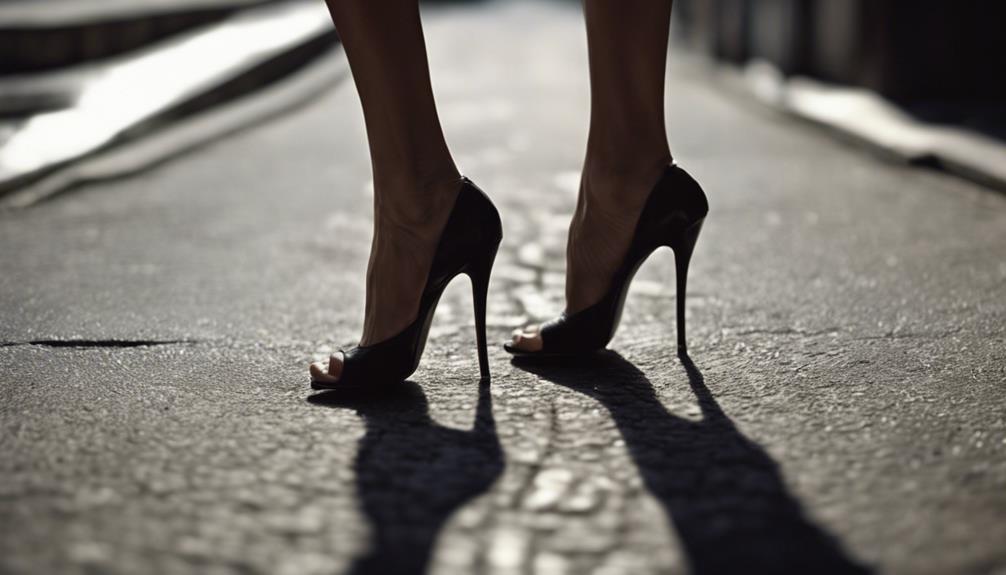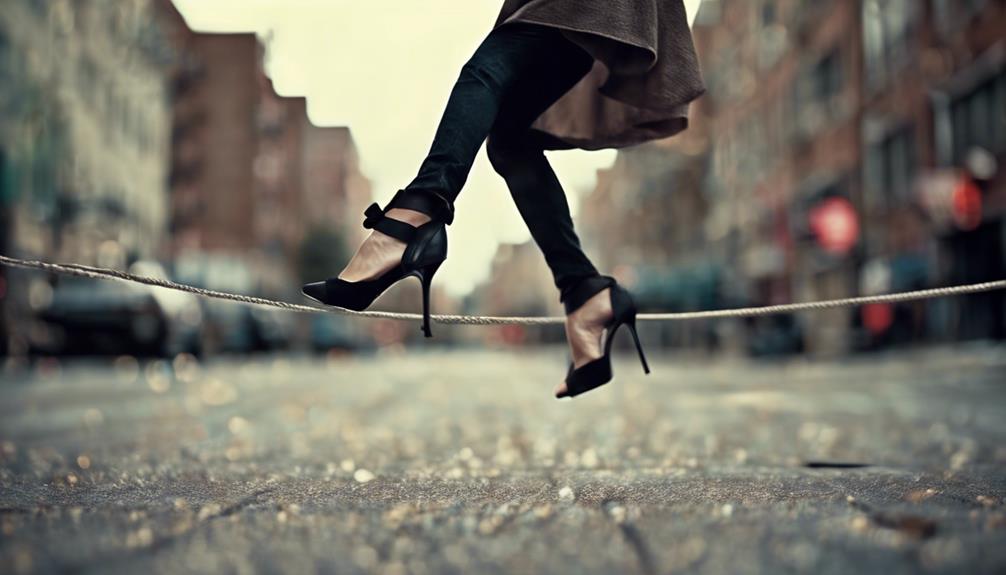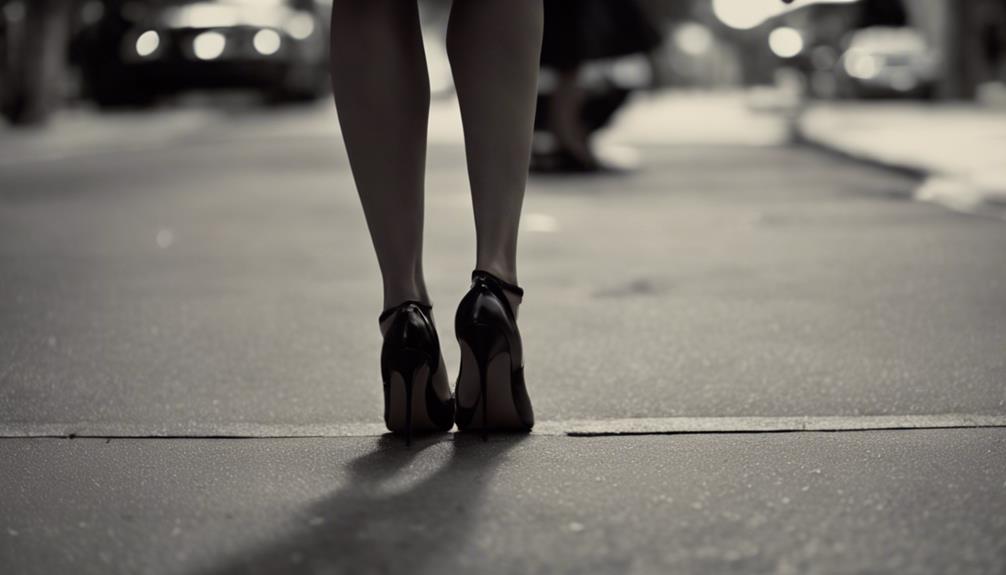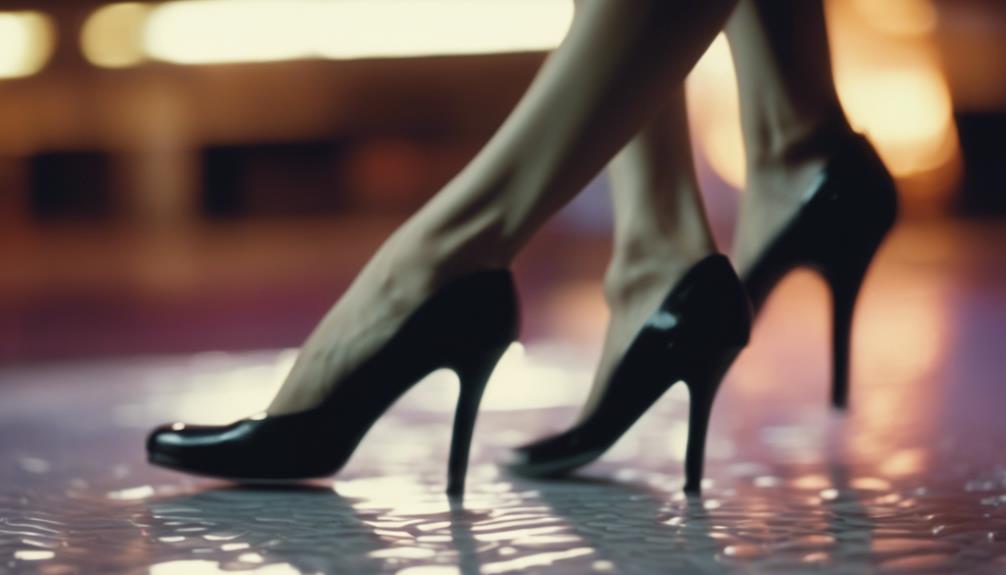Wearing stilettos can be a risky business for my ankles. The elevated heel throws off my natural foot mechanics, cranking up the pressure and twisting angles in my ankle. It feels like I’m teetering on a narrow base, which messes with my balance and stability. Without enough ankle support, I’m basically inviting sprains into my life, especially if I’m in these shoes for the long haul. Sudden moves? They’re a recipe for disaster, making it super easy to misstep and twist my ankle. Stick around, and I’ll share how to outsmart these stylish yet sneaky culprits.
Key Takeaways
- Elevated heel design alters foot biomechanics, increasing the risk of ankle twists due to higher inversion angles.
- The narrow shoe base impacts balance and stability, making it easier to misstep and twist an ankle.
- Lack of sufficient ankle support in stilettos shifts posture and strains ligaments, leading to sprains.
- Stilettos shift the wearer’s center of gravity forward, compromising balance and restricting natural ankle movement.
- Sudden movements in high heels can cause quick shifts that the unstable structure of stilettos cannot support, resulting in sprains.
Elevated Heel Design

The heightened heel design of stilettos greatly increases the risk of ankle sprains by altering the natural biomechanics of the foot. When I step into my favorite pair of stilettos, I’m not just elevating my height; I’m markedly changing how my ankle moves. The elevated heels lead to increased ankle plantarflexion and inversion angles, which basically means my foot is more pointed and tilted, making it far easier for me to twist my ankle.
Research has illuminated that walking in these stylish yet precarious shoes modifies ankle joint kinematics and kinetics in ways that challenge my stability. It’s not just about the look; it’s a biomechanics issue. The peak inversion moment – a fancy term for the point at which my ankle is most likely to twist – is alarmingly higher in stilettos due to these alterations in movement and force.
Understanding the intricate dance of ankle joint kinetics has made me realize that each step in stilettos is a calculated risk. The strain on my ankle ligaments and muscles from the constant ankle plantarflexion and inversion doesn’t just threaten immediate sprains but potentially contributes to long-term instability. It’s a high price for fashion, powered by the biomechanics of elevated heels.
Narrow Shoe Base
I’ve noticed that the narrow shoe base of stilettos has a substantial impact on how we balance. This design leads to heightened pressure on certain parts of our feet, making it more challenging to keep steady.
As a result, our foot stability is reduced, increasing the likelihood of ankle sprains.
Altered Balance Mechanics
Narrow shoe bases in stilettos noticeably alter balance mechanics, elevating the risk of ankle sprains. The slim design greatly reduces the surface area, leading to compromised ankle stability and a heightened likelihood of injuries. With such a lack of support, it’s no surprise that instability and ankle twists are more common.
| Aspect | Impact on Stability |
|---|---|
| Reduced Surface Area | Increases Instability |
| Compromised Ankle Stability | Leads to More Ankle Sprains |
| Lack of Support | Results in Unstable Footing |
| Slim Design | Causes Difficulty in Adjusting to Uneven Surfaces |
| Instability | Triggers Ankle Twists or Rolls |
In stilettos, I’m basically walking on a tightrope, where every step could lead to an ankle sprain due to the narrow shoe base.
Increased Pressure Points
Frequently, stilettos with their narrow bases amplify pressure points on the ankle, compromising stability and increasing the risk of sprains. This confined space in stilettos doesn’t just cramp my style, but also concentrates pressure on specific areas, making my ankles more vulnerable.
It’s all about weight distribution, or the lack thereof, that puts excessive stress on my ankle joint. Wearing high-heeled stilettos that restrict natural ankle movements feels like a gamble with every step, heightening the risk of a painful twist or sprain.
The sheer lack of support and stability in these fashion statements means I’m always a step away from ankle sprains. It’s clear; the narrow shoe bases in stilettos are a stylish pitfall for ankle health.
Reduced Foot Stability
Stilettos, with their slender bases, compromise foot stability, making it harder to avoid ankle sprains. The narrow shoe base greatly reduces the foot’s ability to maintain balance and adequately support the body’s weight. This limitation not only increases the risk of injury but also contributes to instability in the ankle joint.
The challenge of keeping foot balance on such a restricted surface area directly strains the ligaments around the ankle, elevating the likelihood of sprains. Moreover, the absence of a wide base in these fashionable shoes impedes the even distribution of pressure across the foot.
As someone who’s always on the lookout for innovation, it’s clear that the design of stilettos needs a rethink to reduce the incidence of ankle sprains by improving foot stability and pressure distribution.
Insufficient Ankle Support
Why do we often overlook the lack of ankle support in stilettos, despite its significant role in increasing the risk of ankle sprains? It’s perplexing, really, considering the narrow base and high heel of these shoes inherently create instability in the ankle joint. This instability isn’t just about wobbling on a high heel; it’s a deeper issue tied to insufficient ankle support that directly compromises our balance and proprioception.
When I step into a pair of stilettos, the elevated heel height shifts my entire posture, placing undue strain on my ankle ligaments. This isn’t just uncomfortable; it’s a recipe for sprains. The lack of stability features in these shoes means that with every step, I’m courting risk.
What’s more, wearing stilettos for prolonged periods doesn’t just flirt with danger; it practically invites it. The continuous strain on my ankle ligaments from the shoes’ insufficient ankle support increases the likelihood of sprains. It’s a stark reminder that fashion often comes at the cost of our well-being, urging us to rethink our choices for the sake of our ankles.
Altered Center of Gravity

When I slip into a pair of stilettos, the altered center of gravity shifts my weight forward, considerably elevating my risk of an ankle sprain. This precarious position forces my body to compensate, engaging different muscles to maintain my balance. However, this adjustment isn’t always enough to prevent losing balance, especially when the stilettos have a narrow base that offers less stability. It’s a setup that makes it all too easy to roll or twist an ankle, even with the slightest misstep.
The constant plantarflexion, a fancy term for the high-heel posture my foot maintains in stilettos, further impacts my ankle stability. This unnatural position restricts the natural movement of my ankle, limiting my ability to quickly react to uneven surfaces or unexpected shifts in my path. The result? An increased likelihood of spraining my ankle.
Moreover, the design of stilettos inherently provides less stability, making every step a calculated risk. The narrow base, combined with an altered center of gravity, means I’m always a misstep away from potentially rolling or twisting my ankle. It’s a constant balance act, one that demands attention and care to navigate safely.
Prolonged Wear Impact
As I continue to wear high heels over time, my ankle muscles and ligaments weaken, greatly increasing the risk of sprains. This isn’t just about the occasional discomfort; it’s about the long-term impact of prolonged wear on my body’s biomechanics. High heels, by their very design, force my foot into an unnatural position, leaving my ankles vulnerable to injury.
The muscle adaptations that occur from constant high heel use have a domino effect. Not only is there reduced stability in my ankles, but the efficiency and strength of muscles higher up in my leg and even my back are affected. It’s a chain reaction that starts from the ground up, altering the way I move and compromising my balance.
What’s fascinating yet concerning is how these changes in ankle strength and biomechanics can sneak up on me. Over time, as the ankle becomes less stable, I’m not just at risk of sprains; I’m altering the very way I walk, which could have lasting consequences. It’s clear that the allure of high heels comes with a price on my body’s well-being, highlighting the importance of balance and moderation in their use.
Missteps and Twists

I’ve noticed that missteps and sudden changes in direction can be particularly perilous when I’m wearing stilettos. The precision required for correct foot placement is often compromised, leading to a higher risk of ankle sprains.
These movements create a perfect storm for injury, underscoring the need for extra caution.
Incorrect Foot Placement
Incorrect foot placement often leads to missteps and twists while donning stilettos, greatly raising the risk of ankle sprains. The narrow base and towering height of stiletto heels, although a fashion statement, are a recipe for unstable foot positioning. This precarious setup forces my foot into an unnatural position, not only challenging my balance but also upping the chances for those dreaded missteps.
Each time my foot twists or turns unexpectedly, the risk of ligament damage and ankle sprains skyrockets. It’s clear that the anatomy of stilettos, designed for aesthetics, doesn’t quite align with the anatomy of my foot, leaving me vulnerable to injuries from even the smallest misalignment or twist.
Sudden Direction Changes
Moving in high heels, sudden direction changes such as missteps or twists greatly increase the risk of spraining my ankle. The elevated height and narrow base of stilettos make for an unstable platform, heightening the risk with every twist and turn. Here’s a quick visual:
| Aspect of Stilettos | Impact on Ankle Stability |
|---|---|
| Elevated Height | Reduces Balance |
| Narrow Base | Limits Support |
| Unstable Nature | Increases Risk of Twist |
| Sudden Movements | Compromises Support |
| Terrain Changes | Leads to Missteps |
In these shoes, my ankle’s natural movement is constrained, making it all too easy for a quick shift to result in a painful sprain. The combination of an unstable structure and compromised support makes sudden direction changes a dangerous game.
Frequently Asked Questions
What Is the Most Common Way to Get a High Ankle Sprain?
Exploring the most common way to get a high ankle sprain piqued my interest, especially as it relates to my love for innovation and challenging norms.
I’ve discovered that walking on uneven surfaces tops the list. It’s not just about a clumsy moment; it’s about how these surfaces amplify the risk, twisting and potentially breaking the ankle.
It’s made me rethink my shoe choices and how I navigate different terrains.
Why Does My Ankle Hurt With High Heels?
I’ve noticed my ankle hurts when I wear high heels. I’ve learned it’s because these shoes put my foot in an unstable position. This instability increases my risk of sprains.
Wearing heels for a long time can even change my lower leg muscles, making my ankles weaker and less stable. Plus, they stress my ankle joints and can cause ligament damage, affecting my legs and back.
It’s clear my love for heels is a bit of a balancing act!
Why Can’t I Walk in Stilettos?
I’ve realized I can’t walk in stilettos because they greatly alter my balance and gait, putting my ankles at risk.
The unnatural position forces my feet into a precarious stance, making it tough to maintain stability. This constant strain weakens my ankles over time, reducing muscle strength and balance in my lower legs.
It’s clear that understanding ankle biomechanics is key to preventing injuries and mastering the art of walking in these high heels.
What Is the Common Cause High Ankle Sprain?
Fascinatingly, I’ve discovered that high ankle sprains often originate from the awkward angles and instability our ankles endure, particularly when we’re pushing the boundaries with innovative footwear like stilettos.
The way these heels force our feet into unnatural positions greatly increases the risk for injuries.
It’s as if our ankles are constantly maneuvering a tightrope, balancing between style and safety, making high ankle sprains a common casualty in the pursuit of fashion-forward strides.
Conclusion
After diving into the precarious world of stilettos, it’s clear why ankle sprains are a common casualty. The design practically sets us up for a fall, with a narrow base and sky-high heels altering our center of gravity.
One striking statistic caught my eye: nearly 80% of stiletto-related injuries are ankle sprains. That’s a staggering number, highlighting the risk we take with every fashionable step.
It’s a reminder that sometimes, beauty really does come at a price.

